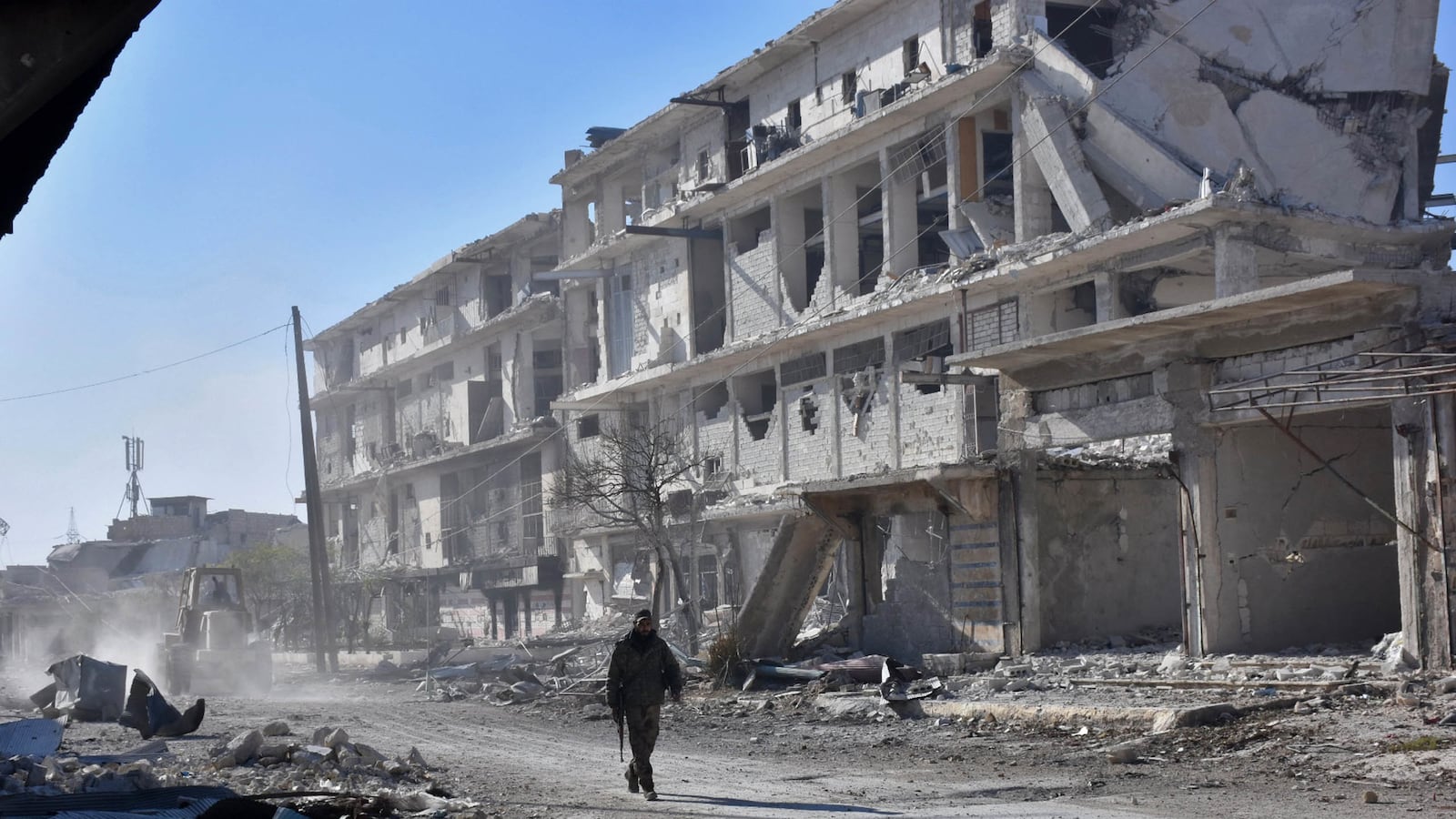BEIRUT — Over the course of the last three days Syrian rebels suffered their worst defeat in four years as forces loyal to dictator Bashar al-Assad managed to sack a third of eastern Aleppo.
In a fortnight, at least 500 people have been killed and 1,000 more wounded as Russian and Syrian warplanes pounded the city from the sky while a consortium of Syrian soldiers and Iranian-built militias stormed it on the ground.
The assault came from east and west in an apparent effort to bisect rebel territory, which is already geographically isolated from the rest of the province.
First to fall on Saturday was the Hanano Residence neighborhood, a dense complex of apartment buildings and once a great prize for rebels who stormed it in 2012. That was followed Sunday by Jabal Badro and Al-Sakhour, where a chemical weapons attack killed six the week before.
One humanitarian activist from the city described the current situation to The Daily Beast as “a total catastrophe.”
“What’s happening now in Aleppo is a genocide against the civilians,” said Khaled Khatib, a Turkey-based media official for the Syrian Civil Defense, also known as the White Helmets.
So ferocious is the bombardment that after Sunday’s strikes as many as 35 people remained trapped under rubble on Monday, unable to be reached by the White Helmets, whose vehicles and other rescue equipment have themselves been knocked out by airstrikes, according to a statement released by the organization.
Since November 15, it read, there have been a documented 2,000 airstrikes, over 7,000 rocket strikes, as well as ballistic missiles, cluster munitions, and chlorine gas dropped on various neighborhoods. All hospitals are now out of service.
Asked what he thought would happen to the city now, Khatib was at a loss.
“In truth, we don’t know what our fate is in the coming days. … Unfortunately we don’t see any movement from the international community, or the major powers who claim to be friends of the Syrian people. We try to retain a sliver of hope that the situation may improve, but if nobody moves to stop the regime and Russian bombardment of civilians, we fear the greatest humanitarian catastrophe of the modern era will take place.”
Certainly it could be the greatest catastrophe this century has seen.
Some 16,000 residents already have fled to regime-held areas or to Sheikh Maqsud, a district under Kurdish control, according to the London-based Syrian Observatory for Human Rights. But they are still in danger.
“Aleppo is now ground zero for the Assad regime’s starve-or-submit policy,” Anna Nolan of the Syria Campaign, an advocacy group, told The Daily Beast. “Without international action to stop it we will see both civilian suffering and demographic engineering on an unprecedented scale.”
The regime has lined up green buses for the purposes of civilian “evacuation,” but without any international presence or witnesses, said Nolan, “We can only assume the worst for those that board these buses. If your house is on fire you don't call the arsonist to rescue you.”
Formerly Syria’s most populous city, prior to the exodus of many tens of thousands, parts of Aleppo fell to anti-regime insurgents in the summer of 2012. For most of Syria’s five-and-a-half-year civil war, those parts of the city have served as the enduring symbol of what was once seen as an inevitably victorious revolution, in days when the prospect of a Western-led intervention still seemed likely.
As those hopes faded, particularly after Assad’s 2013 chemical attack went unpunished, East Aleppo acted as a steadfast irritant to a resurgent regime that had always promised to “liberate” from “terrorists” every last inch of Syria.
Today, however, the rebel citadel lies in ruins, a jagged and pocked wasteland where some 250,000 to 280,000 civilians still remain and the rebel contingent now largely consists of Islamist or Salafist brigades, including the al-Qaeda affiliate formerly known as Jabhat al-Nusra. There is no ISIS presence, however, despite what Russian and Syrian state media have persistently claimed.
According to Jennifer Cafarella, a Syria analyst at the Washington, D.C.-based Institute for the Study of War, the blitzkrieg marks the first time that pro-regime fighters have seized major swaths of dense urban terrain.
Also of note: that fighting force consists mainly of regular soldiers of the Syrian Arab Army rather than Iranian-built militias, including Lebanese Hezbollah and Iraqi Shia factions, which have tended to do the regime’s heavy lifting in Aleppo province. Those elements now provide reinforcements, which may have been how what appears to have been a fresh division was able to move so quickly in the northeast.
That said, Cafarella believes the alacrity of Assad’s successes owes more to months of sustained aerial bombardment backed by a starvation siege rather than to any new military capability.
“The opposition is not yet collapsing,” she said, “but it is losing, and choosing carefully which fights to muster its man- and firepower.”
U.S. military and intelligence officials have warned previously that the fall of Aleppo poses a dire counterterrorism challenge as it will surely lead to the further radicalization of the rebellion. It will also exacerbate tensions between the mostly Sunni Arab opponents of the regime — including those backed by the CIA, at least until incoming President Donald Trump decides otherwise — and Kurdish People’s Defense Units, the YPG militias, most of whom are backed by the Pentagon as part of Operation Inherent Resolve, the coalition war against ISIS.
Technically, the YPG that controls Sheikh Maqsud is not receiving U.S. support; only those units fighting the terror army east of the Euphrates River and closer to the ISIS “capital” of Raqqa do.
However, this is a distinction without much of a difference, Cafarella says, as all YPG units are controlled by the same political party in Syria and committed to the same expansionist project of Kurdish state-building. This has lead them to tactical understandings with the Assad regime in the past.
Partly as a result, the public perception among Sunni Arabs is that the U.S. proxy, the YPG, is de facto aligned with the dictatorship committed to their extermination, a perception that will only help jihadists in the long term.
Indeed, rebels have already accused the YPG of attacking them in concert with Assad’s forces in the last 72 hours, especially in the neighborhoods of Hullok and Bustan al-Basha, both of which have now been recaptured, according to Syrian state media. The YPG units here have benefited from regime armaments and air support, according to Cafarella. They are also rumored to have received assistance from Russian Spetsnaz, or special forces.
“So the view from the ground is that rebels were forced to hand over terrain to a U.S.-backed group aligned with the regime,” Cafarella said. “This will have implications for the fight against ISIS. The fall of Aleppo will also force previously independent opposition groups into a greater dependence on al Qaeda.”
The battle for Aleppo may be drawing to a close. The long war against extremism is about to grow much worse.
— Alex Rowell reported from Beirut, Michael Weiss reported from New York






